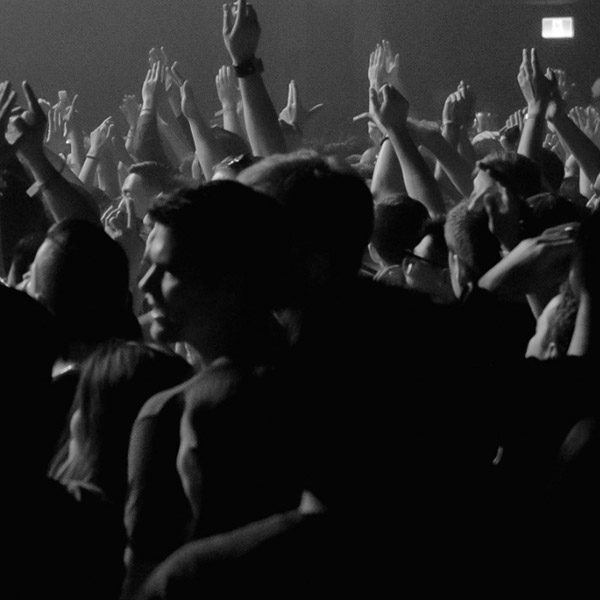Nortec: Bostich + Fussible Talk 25 Years of Their Groundbreaking Mix of Norteño and Electronic Music
At the dawn of the new millennium, Nortec Collective transformed the traditional sounds of northern Mexico into something entirely unheard of — a fusion of regional Mexican and electronic music that redefined a generation. Shorthand for “norteño” and “techno,” Nortec was culture rewired, fusing the bright accordions and brassy tubas of banda with driving techno and experimental beats. But what emerged wasn’t merely a genre — it was a sonic identity, a collision of past and future that encapsulated the spirit of Tijuana.
While Nortec Collective began as a collaborative effort of forward-thinking Baja California DJ/producers and visual artists, its global breakthrough was powered by the duo of Ramón Amezcua (Bostich) and Pepe Mogt (Fussible). With their boundary-pushing vision, Bostich + Fussible carried the sound, ethos, and imagery of Nortec beyond the Tijuana clubs and into Coachella (2001 and 2015), Cirque du Soleil, the 2011 Pan American Games, and events spanning Japan, Brazil, France, and Argentina. Along the way, they collaborated with icons like Morrissey, Beck, Tom Tom Club and Kraftwerk. Nortec Collective’s seminal album Tijuana Sessions, Vol. 3 (2005) earned them two Latin Grammy nominations.
From the outset, Nortec’s work challenged conventions, subverting stereotypes of Mexican identity — like the outsider trope of the gun-slinging charro donning a weed plant shirt in a lawless Tijuana — while exploring new artistic terrain. Their influence hasn’t just resonated in music but across academia and art, sparking critical studies like Paso del Nortec: This is Tijuana! (2004), by Jose Manuel Valenzuela, and Nor-tec Rifa!: Electronic Dance Music from Tijuana to the World (2008) by Alejandro L. Madrid. Most recently, they’ve been the subject of a chapter in 2024’s Con sus charros cibernéticos: Un paseo por la música electrónica en México by Juan Antonio Vargas Barraza.

Today, the ripple effects of Nortec’s inventive sound can be heard in the rise of electro corridos, a genre-blurring movement led by acts like Fuerza Regida (whose Jersey corridos album Pero No Te Enamores made waves), DannyLux (“House of Lux”), Codiciado (“Gabachas”), Grupo Marca Registrada, Luis R. Conriquez, and Los Esquiveles. Even this week, SoundCloud spotlighted the growing prominence of the movement among listeners, a testament to the enduring relevance of the fusion that Nortec originated.
Now, 25 years after the release of their first project as Bostich + Fussible, the pair continue to celebrate their legacy while adding new milestones. Last month, their single “Tijuana Sound Machine” from their Grammy-nominated 2008 album of the same name was certified double-platinum by AMPROFON in Mexico. With festival appearances this year at Vive Latino, Pa’l Norte, and Festival Arre, Nortec’s Bostich + Fussible continue to demonstrate the enduring resonance of their influence — not only for themselves but for the revolutionary fusion that changed how we hear and imagine Mexican music.
Below, the duo reflect on both their legacy and their place in contemporary music.
Fussible: Nortec started out as a collective back in ’99. Ramón and I had been making electronic music since the ’80s, experimenting with genres like industrial, breakbeats, EDM and house. Even though our paths were pretty different, in the mid-’90s we came up with an alias called Monitor, which leaned more toward experimental electronic stuff with a touch of breakbeat.
Neither Ramón nor I liked norteño or banda music because we grew up with different influences. It wasn’t because we had anything against that music — we’d hear it at family parties, and it’s very common in Tijuana. But when you grow up with electronic music coming across the border, whether through radio stations or record stores back then, our passion was electronic music — that’s what shaped our influences.
From there, I got my hands on some tapes of norteño music with snare drums and trumpets recorded by local bands. These groups made demos to land gigs in bars and nightclubs around Tijuana. They’d record covers of artists like Los Tigres, El Recodo, Intocable and even a norteño version of the Beatles in Spanish, all in their own style. While experimenting with mixing their recordings with ambient techno sounds, the track “Ventilador” was born, giving me the idea for an entirely new project.

At first, Ramón was a bit skeptical and thought it was a joke. I told him we could do something with it. More than anything, it was about searching for identity, an opportunity to create something different and shake things up, but only as a one-off project. Then Ramón released “Polaris,” followed by “Trip to Ensenada” [by Fussible] and “Tijuana Bass.” That set the foundation.
We had several musician friends in Tijuana who were making electronic music. We put out a call to see if they wanted to join in under the same concept and use the samples I had collected. However, many thought it was a joke or just weren’t interested. But a few with production experience jumped on board. We brought in Terrestre and Plantón from Ensenada, who had a strong background in advanced electronic music, jazz, and even rock. Then there were Hiperboreal and Panóptica, who were doing their own thing. Designers Jorge Verdín (Clorofila) and Fritz Torres also joined in, contributing to both the music and the visuals.
When we released our first tracks, a DJ from Tijuana named Tolo decided to use his budget, which was originally meant for house music on vinyl, and decided to fund the first Nortec vinyl. That’s how it all took off — with finished songs and a collective. It was the birth of the Nortec Collective.
Ramón and I had more material, so we dropped our first release, Bostich + Fussible Remixes, which came out on [the label] Opción Sónica in early 2000. That’s why the 25 years of Bostich + Fussible. The collective’s performances came to an end around 2006 or 2007, with one final show featuring everyone together. After that, each member went on to release their own albums individually. But Bostich and Fussible made a comeback with Tijuana Sound Machine in 2008. We kept creating more and found our formula for working and performing together.
We decided to create a story based on that car [featured on the album cover]. That’s when we came up with the trilogy about this mysterious car that you don’t know if it flies, smuggles undocumented immigrants or illegal goods, or maybe even traffics records. Its wheels are speakers, and inside there’s a norteño ghost. The design, created by Fritz, was also nominated for a Latin Grammy for best recording package.
Bostich: Each of our albums has reflected that [Tijuana] reality. In the beginning, the first Nortec cover, a digitized norteño, was very much tied to the concept of the music. It was a deconstruction through technology of a sound that was entirely regional and local. Even though norteño and banda music didn’t originate in Tijuana, it’s the music we grew up with in our city.
During the Tijuana Sound Machine era, Tijuana was an extremely violent city. It was necessary to keep your name out of phone directories to avoid being tracked or located. Many people left the city. There were a lot of kidnappings, and that reality was reflected in the themes of the albums, like “Retén” and “Akai 47.”
Bulevar 2000 (2010) is about a highway in our city that was built to support Tijuana’s growth but ended up becoming a place where many murders happened, with bodies wrapped in blankets being dumped there. Interestingly, when people Googled “Bulevar 2000” or on other search engines back then, all they found were stories about violent incidents. But when the Bulevar 2000 album was released, people started seeing the album or references to Nortec in the top search results. It was a complete shift and has changed so much since then.
Our latest album, De Sur a Norte (2022), reflects Today’s Tijuana, where the city no longer has its own distinct identity. Everything is so interconnected now. People listen to music from all over the world. You can go to Mérida, and folks there are listening to the same music we’re hearing in Tijuana — not just the sounds of guitars, trumpets, tubas and accordions, but also influences from other parts of the city. Pepe and I have tried to authentically capture our reality as Tijuana natives and what we’re experiencing today.
Tijuana, as a border city and a constantly changing place, has completely different sides to it. Every five to seven years, Tijuana isn’t the same city anymore. The Tijuana of ’99 and 2000, I can tell you, was industrial — it was a time of economic, social and political growth. There was also this new concept of globalization. Pepe and I were sharing our music in a very different way. Our first tracks on Napster were already among the most listened to, according to the creator of Napster himself when we met him. In fact, Nortec’s original slogan was “download is culture.” People would say, “Why are you giving music away? Why is it free? There won’t be any business; there won’t be anything.” But all of that was part of the vision of what was coming at the time — the era of downloads.

The Rise of Electro Corridos
Bostich: We’re very aware that we’re not necessarily an influence on them [today’s acts in the genre]. It’s more a reflection of technology — an inevitable way of applying it to any type of music. Electronic music was bound to find its way into every musical style sooner or later. A few months ago, we played at Festival Arre in Mexico City, which focuses on regional Mexican music. Most of the crowd — 18, 20 years old — no longer wear cowboy hats or boots. We were a little nervous about how Nortec would be received, especially since Fuerza Regida performed right before us. The place was packed, with over 20,000 people.
And when they finished playing, the stage emptied out completely, and then we started. At first, there were maybe 50 to 100 people in front of us, tops. We thought, “Well, that’s it for us.” But then it filled up immediately, I think just like it did for the others. The most surprising thing was that the musicians from those bands stayed to watch us. They were off to the side, like, “Who are they? What are they doing? Why are they mixing this music?” We truly believe that the connection between the roots of Mexican music and electronic music was something inevitable — sooner or later, it was bound to happen.
“Tijuana Sound Machine” is included on The Story of Nacional Records, Vol. 1 limited edition double vinyl. The duo is slated to perform in Mexico City’s Pepsi Center on Aug. 30. They are currently working on new music.
Isabela Raygoza
Billboard







